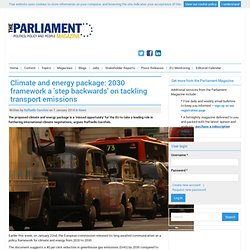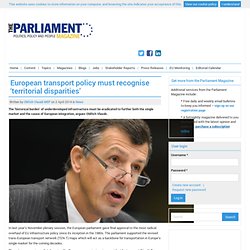

Www.uitp.org/sites/default/files/members/140124 Arthur D. Little %26 UITP_Future of Urban Mobility 2 0_Full study.pdf. SHIFT²RAIL- The European Rail R&D Initiative. Next Generation of Train Control systems. Why Obama Just Named Sweden As A Model For Energy Policy. Cap And Trade Published on September 10th, 2013 | by Important Media Cross-Post Originally published on Think Progress.

By Ryan Koronowski. US President Barack Obama, center, and Sweden’s Prime Minister Fredrik Reinfeldt hold a press conference at Rosenbad, the seat of the Swedish government in Stockholm, Sweden, Wednesday, Sept. 4, 2013.CREDIT: (Credit: AP/Frank Augstein) During a press conference with Sweden’s Prime Minister Fredrik Reinfeldt on Wednesday afternoon Stockholm time, President Obama was asked what the United States could learn from Sweden. What I know about Sweden, I think, offers us some good lessons. So what can the U.S. learn from Sweden? Sweden gets most of its electricity from hydroelectric and nuclear power, dating from investments in the 50s and 60s. Zero Emission Urban Bus System. Zero Emission Urban Bus System ZeEUS (Zero Emission Urban Bus System) is a 42-month demonstration project funded by the European Commission in which different innovative technological solutions for electric buses will be demonstrated in eight cities: Barcelona, Bonn, Glasgow, London, Münster, Plzen, Stockholm and one city in Italy.

ZeEUS analyses will be used to develop guidelines and tools to help stakeholders introduce electrified bus systems in other European cities. An observatory will also be established to discuss the progress of bus system electrification in Europe and contribute to electric bus fleet deployment strategies. The project has 40 partners representing all categories of mobility stakeholders throughout Europe and is coordinated by The International Association of Public Transport (UITP). Intelligent Transport Systems in urban areas.
World-class demonstration and testing arenas. Urban Mobility Package (december 2013) Le Parlement soutient le système eCall dans les voitures afin de sauver des vies. D'ici octobre 2015, tous les nouveaux modèles de voitures et de véhicules utilitaires légers dans l'UE devraient être équipés de dispositifs d'appel d'urgence qui alertent automatiquement les services de secours en cas d'accident, ont affirmé les députés lors d'un vote ce mercredi sur un projet législatif concernant la mise en place du système eCall.

En 2012, les accidents de la route ont coûté la vie à 28 000 personnes et fait 1,5 million de blessés dans l'UE. Climate and energy package: 2030 framework a 'step backwards' on tackling transport emissions. Earlier this week, on January 22nd, the European commission released its long awaited communication on a policy framework for climate and energy from 2020 to 2030.

The document suggests a 40 per cent reduction in greenhouse gas emissions (GHG) by 2030 compared to 1990 levels, 27 per cent use of renewable energy sources, and an indicative target for energy efficiency improvement of 25 per cent. The EU has long committed to tackle the adverse effects climate change, while also ensuring Europe's energy security. The 2009 climate and energy package was a first ambitious step to ascertain shift in energy use and develop domestic reliance on resource. The then – European institutions managed in addressing the major challenges for the EU with targeted national mandates and sector specific requirements. On the contrary, the communication for the 2030 framework is a step backwards. Strasbourg round-up: 2020 target to reduce CO2 emissions from new passenger cars. In 2020 manufacturers can exclude the dirtiest five per cent of their fleet from the calculations.

And for three years car producers can count especially efficient and clean cars multiple times towards their CO2 target. In reality the 2020 target therefore will only be met in 2023 It's hard to recall that a decade ago MEPs were having to press the commission to introduce legislation to reduce CO2 emissions from cars CO2 consumption and emissions are directly linked, and this ratio needs to be improved. Thomas Ulmer is parliament's rapporteur on 2020 target to reduce CO2 emissions from new passenger cars In the negotiations which have resulted from the trilogue discussions on CO2 emissions from new vehicles, I see a good compromise between the interests of the industry on the one hand and the environment and the consumer on the other .
In contrast to the USA, eco-innovations play no part in this regulation. All credit to the whizz kids who design and engineer our vehicles. European transport policy must recognise ‘territorial disparities’ In last year’s November plenary session, the European parliament gave final approval to the most radical overhaul of EU infrastructure policy since its inception in the 1980s.

The parliament supported the revised trans-European transport network (TEN-T) maps which will act as a backbone for transportation in Europe’s single market for the coming decades. The outcome was immediately praised by European commission vice-president for transport Siim Kallas, and one must admit that after tough multilateral negotiations, a reasonable compromise acceptable for all EU institutions as well as individual member states has been reached. However, will the initial enthusiasm stay when the new cohesion policy framework 2014-2020 is launched? Will the envisaged plans really be achieved? And what will it bring to EU regions? In my opinion, in the case of the revised TEN-T maps, we have managed to reach a balanced compromise. UN report shows need for decisive action on EU transport policies says T&E.
Transport & Environment is calling for decisive action on vehicle regulations to help drive down emissions and increase demand for e-mobility following the publication yesterday (13th April) of the latest United Nations Intergovernmental Panel on Climate Change (IPCC) report.

The report alerts global leaders to the growing threat of uncontrolled transport emissions. The UN's climate panel says that transport is set to become the world’s biggest source of CO2 emissions unless lawmakers take strong action now. The report states: ‘Without aggressive and sustained policies (to cut CO2 from cars and trucks), transport emissions could increase at a faster rate than emissions from any other sector.’ ELECTROMOBILITY – Guiding E... - Information Centre - Research & Innovation. One of the most important tasks facing the world today is the need to reduce its dependence on oil and other fossil fuels.

Nowhere is this felt more keenly than in the transport sector, which alone accounts for some 25% of global greenhouse gas emissions. In response, car manufacturers around the world are focusing intensely on developing prototype electric vehicles. China, for example, has set a target that 50% of new vehicles on its roads should be electric by 2020. Although it is widely recognised that electric cars will only make a significant difference if they are accompanied by a move towards smart grids and cleaner electricity generation, global competition for the electric vehicle market will be intense. The speed with which car manufacturers and their suppliers are able to develop these new vehicles and bring them to market is likely to be a decisive factor. Ec.europa.eu/research/fp7/pdf/country-profiles/sweden/country_profile_and_featured_projects.pdf#view=fit&pagemode=none.
Dataportalen. European smart cities. 'Suburbs will be part of inner-city Stockholm' In pictures The forty-flat student housing going up in Gubbängen.

Photo: Utopia Published: 25 Apr 2014 15:01 GMT+02:00Updated: 25 Apr 2014 15:01 GMT+02:00 With most stories about Stockholm housing brimming with despair, The Local shows some of city hall's ongoing new-build projects. These include what looks like a spaceship for students. Smart, Green and Integrated Transport. The Transport Challenge is allocated a budget of €6 339 million for the period 2014-2020 and will contribute to four key objectives, each supported by specific activities.
